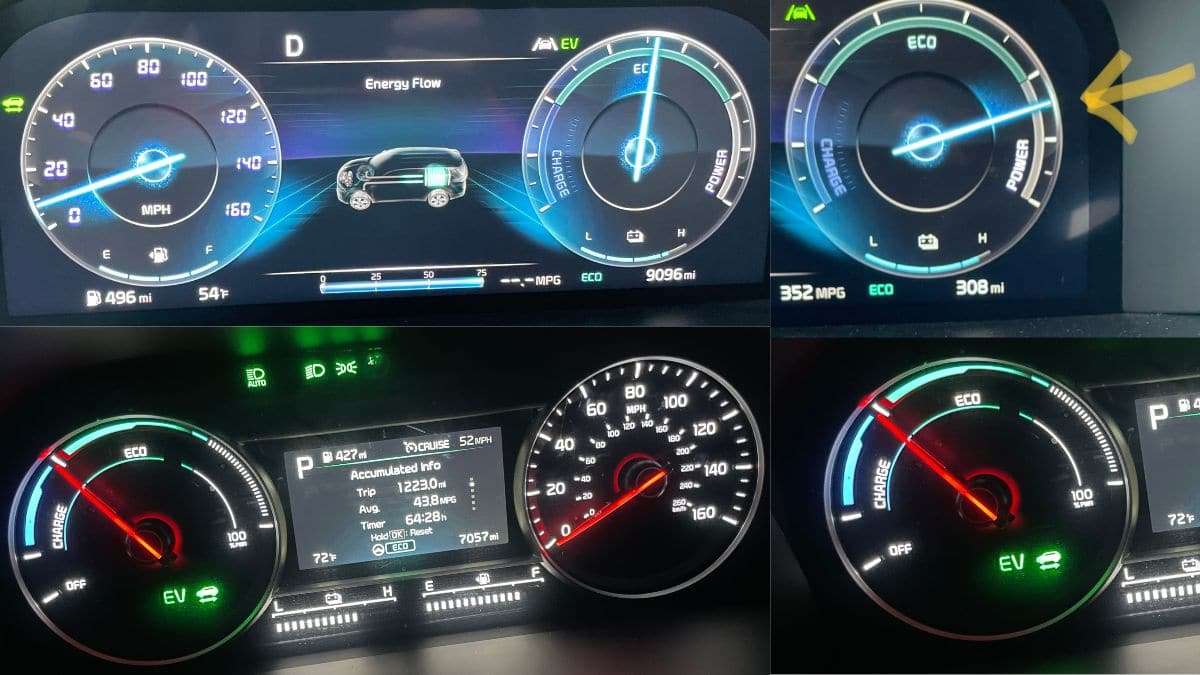Recently, I did a test to see if I might have lost any range from the hybrid battery. I also repeated a 39.6 mile round trip drive twice this week, once with my 12 and a half foot paddle board strapped to the roof, and all these tests confirm I am still able to get 40+ miles per charge in my Kia Sorento PHEV, as long as I drive it gently. But how specifically do I beat the estimated 32 miles of electric only range and EPA predicted fuel efficiency figures, routinely, in my relatively big, blocky Kia SUV? Here’s the techniques I use in as much detail as I can provide in a short piece.
First, slow down. Drive the speed limit (don’t worry, you won’t get run off the road). Then, learn to use the displays as a guide and retrain your foot to gently apply pressure to the accelerator. There are multiple screens one can select in the Kia Sorento hybrids that can help you track your fuel efficiency, but the “tachometer” display (on higher trim versions, or built in to the dashboard on the left hand side in the lower trim versions) shows you a dial with a needle and three distinct sections: Charge (which means electricity is flowing in to the hybrid battery), Eco (which means the motors are operating in a more efficient manner), and Power (or PWR in lower trims, which mean the motors are delivering more power and thus less efficiency). In the header image for this article you can see the different Sorento hybrid displays; as long as you keep the needle in the Eco or Charge ranges, you can keep the vehicle running on the battery longer. In the PHEV at least, brief forays into the first ¼ of the Power range won’t necessarily start the gas engine, either (by brief I mean for a few seconds at most).
Second, learn to coast as much as possible (potentially incorporating the pulse and glide technique), for example whenever the road might go downhill but also on flat stretches, and to stretch out braking distances to as long as is safe to do so (i.e. apply the brakes as gently and as early as possible when you know you must slow down or stop). The idea is to prolong the time you are recharging the battery from braking, or coasting, and to avoid hard stops which will not convert as much of your kinetic energy into electricity. Also, if you can avoid coming to a full stop by slowing enough the light will turn or the car in front of you will move forward before you get to it, try to do so as long as you aren’t violating any traffic laws (like stopping at stop signs or lights) and are driving safely. This preservation of your momentum saves you from having to otherwise expend charge from the battery to speed back up.
Third, pay attention to your aerodynamics and other details about your vehicle, like extra weight in the trunk you might not always need.Also, don’t just use controls willy-nilly. The Auto climate control function is wonderful for people who just like to set it and forget it, but it wastes energy (and will turn on the gas engine when it's cold out, which you may not want to do unless you need it). Set your temperature manually and avoid using heat or AC except when you need it. Strapping things to your roof or onto the back of your rig is going to negatively impact your airflow and thus reduce your efficiency. Finally, make sure your tires are inflated properly (I overinflate mine a few pounds, preferring to keep them at 40 PSI cold rather than 37 PSI, which also helps in cold weather when the TPMS will sometimes give a warning as colder air condenses).
Some may balk at all these different steps, or think its just too complicated. Maybe you want to get better fuel efficiency but don’t have the patience to do all this. Maybe pick one or two techniques and start there, see where it takes you (they are more or less listed in order of impact). Questions? Want to know more about a certain technique or have a question about how I did something? Please leave your comments and questions below.
Images courtesy of Justin Hart.
Justin Hart has owned and driven electric vehicles for over 15 years, including a first generation Nissan LEAF, second generation Chevy Volt, Tesla Model 3, an electric bicycle and most recently a Kia Sorento PHEV. He is also an avid SUP rider, poet, photographer and wine lover. He enjoys taking long EV and PHEV road trips to beautiful and serene places with the people he loves. Follow Justin on https://www.torquenews.com/kia for regular electric and hybrid news coverage.





